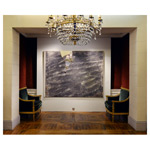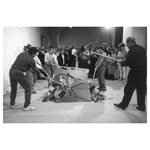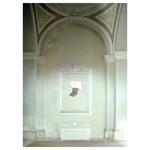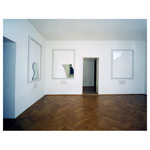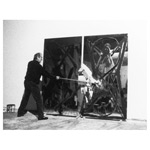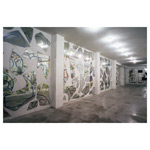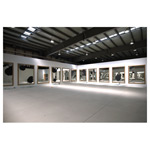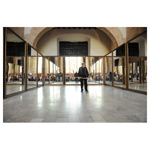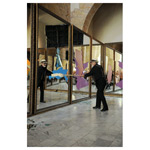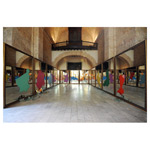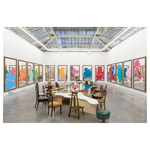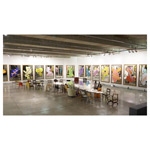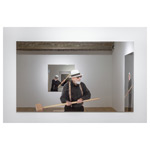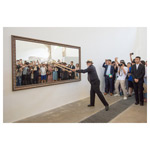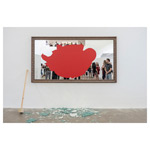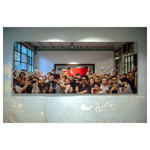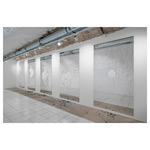With the performance Twentytwo Less Two made at the 2009 Venice Biennale, Pistoletto began a series of new works based on the breaking of the mirror, which would have wide visibility in the following years. However, some precedents in this regard should be recalled.
In 1993, on the occasion of one of his exhibitions at the Museum of Contemporary Art in Warsaw, Pistoletto destroyed and reconstructed the Metrocube of Infinity (1966) in front of the public. Pistoletto repeated this action several times in the following years, and in his 2013 exhibition at the Louvre he also exhibited the Metrocube of Infinity alongside another example of the destroyed work.
In 1986 he created a group of 9 works, titled Mir-Noir, by dividing a mirror into 9 parts and applying each fragment to a rectangular paper surface, entirely covered with black marks traced in charcoal and applied to canvas. The surfaces covered with black marks used for Mir-Noir were made by Pistoletto during his exhibition The Time of the Mirror at the Magazine in Grenoble in the same year, during which Pistoletto had covered, over the course of almost two months, all the walls of the building, a total area of 680 square meters, with strips of paper on which he had traced black marks in charcoal.
On the occasion of the exhibition Ad Usum Fabricae held in 1995 at the Church of San Domenico, Pistoletto created an installation using the stucco frames in the building, inside of which were religious images and which remained empty after restoration. Pistoletto takes a mirror the size of the frames, breaks it into 12 parts and inserts each part into one of the frames. Also placed at each frame are 12 marble plaques engraved with the following inscriptions: The Invisible Seed of Art; Con - Text; 35 Years Inside the Mirror; Unveiling - Revealing; Sign Art Not Art of the Sign; Unique Fragment; The True; Memory of the Origin; The Unknown; Art Project; Division - Multiplication of the Mirror; Self-Portrait of the Mirror.
The following year, in 1996, he produced a similar work, About The Mirror, shown in the exhibition of the same name at the Tanit Gallery in Munich, a group of seven works consisting of a mirror divided into seven fragments, each placed within a simple white frame leaning against the gallery wall. Again at each frame is a marble plaque engraved with the following inscriptions: The Icon; Without Sign; The Beyond; Contemporary Art; Vitrail; Art Takes on Religion; Is There God? Yes, I am.
In 1995 in Pescara, during the exhibition In Uso, Pistoletto gave a lecture, entitled Cancellation of the Mirror, during which he used two side-by-side mirrors, placed in front of the audience, on which he traced marks with a large paintbrush while explaining the evolution of his work. At the end of the lecture, when the mirrors are almost entirely covered with paint, Pistoletto destroys one of the mirror with a large hammer.
In 1999 at the Michetti Museum in Francavilla al Mare, Pistoletto covers an entire wall with large mirror fragments. The following year, in his solo exhibition titled Fractals, at Galleria Cesare Manzo in Pescara, all the walls of the gallery are covered with fragments of mirrors, on which colored marks or numerical sequences are traced.
At the opening ceremony of the Venice Biennale in 2009 Pistoletto presented the action and installation Twenty-Two Less Two. Along the walls of a large room located at the beginning of the route through the Arsenale were placed 22 large mirrors measuring 3 by 2 meters and set in gilt frames. In front of a crowd of visitors and photographers recording the action, and who were reflected in their turn in the mirrors, Pistoletto started to strike and shatter the mirrors with a large hammer, creating large black holes of different shapes on their surfaces. At the end of the action the mirrors and the broken pieces that had fallen onto the floor were left on display as an installation. The relationship that was created in each shattered mirror between the remaining reflective surface and the black one produced by the breakage proposed once again the dynamic between reflective surface and photographic image in the Mirror Paintings, turning them into a sort of abstract version of those works. The reflections between the mirrors and to an even greater extent the ones produced between the innumerable fragments resulting from the breakage represented on the other hand a further development of the research initiated in 1978 with the works of the series Division and Multiplication of the Mirror.
Pistoletto has staged similar performances and made similar installations on other occasions, in some cases entrusting the act of breaking the mirrors to others, as happened for example with Seventeen Less One, the first work in this series, presented at the Yokohama Triennale in 2008 and acquired by the Museum of Modern Art in New York both as an action and as an installation. The Museo Nacional de Bellas Artes in Havana has in its permanent collection the installation Thirteen Less One, in this case created personally by Pistoletto in 2015 in the spaces of the museum.
In the work Respect, created by Pistoletto in 2016 with a performance on the occasion of his exhibition Respect - Art, Education & Politics at the VHN gallery in Paris, the holes produced in the 24 framed mirrors that make up the work allow the underlying surface of a different color with the word “Respect” in 24 different languages to emerge in each mirror. An action similar to that carried out in 2018 with the work Twenty Six Less One, created by Pistoletto with a performance at the Museum of Contemporary Art in Santiago, Chile, on the occasion of his exhibition Cada punto es el centro del universo, cada persona es el centro de la sociedad, in which the underlying word that appeared on the colored surface below the broken mirrors is “understanding”.
In one of the most recent works in this series, White and Light, made on the occasion of his exhibition entitled Nouvelle Perspective at the Galleria Continua in Paris in 2024, Pistoletto shatters four mirrors, unframed, glued to the gallery wall, creating holes on their surface that show the white wall below. In one respect, this work recalls some of his 1964 group of conceptual works called Plexiglas, such as Muro, consisting of a simple sheet of Plexiglas leaning against the wall. On the other hand, it recalls several recent Mirror Paintings having a broken barrier as their subject, such as Beyond the Wall (2018), Hole in the Wire Mesh (2018), Hole in Glass (2020), The Wall Broken Through (2024), and Murales Panic (2024).
“The large framed mirrors placed around the walls of the room are intact at first. They open the space by mirroring each other and multiplying the presence of observers.
The mirror offers its surface to physical life, as a witness to its unlimited extension in space and time. When the mirror is shattered its reflective power is not lost but multiplied, as many times as there are fragments. As in fractals, each fragment of the mirror, regardless of its size, retains the properties of the great mirror, which reflects the totality of what exists. During the performance, the breaking of each mirror framed mirror is like a small galactic explosion that multiplies the particles of the reflection, and remains in the exhibition as a memory of a precise instant of the past ceaselessly reflected in a new present.
Each broken mirror painting is thus a document of an event that marks a precise moment in the flow of time. The black coating that appears behind the broken mirror suggests the dark void that contains the lights of the firmament. It also appears, however, as a black hole that engulfs those lights to eject them again in a new explosion. The mirror in the center of the room remains intact, in reference to the seed of the ceaseless regeneration of light and life. There is a dramatic power in this virtual, artistic process that corresponds to the real. Yet the drama is resolved in emotional moments that, upon reflection, lead us to think about our own existence.”
(M. Pistoletto, Seventeen Less One, in Yokohama Triennale, catalogue of the exhibition, 2008)
“In the mirror painting we have a fixed photographic image, one that does not change but coexists with the present that is continually changing. [...] In Venice the mirror was alone, without a fixed figure, that is to say without memory, a present that expanded ad infinitum. This present needed memory. By “smashing” the mirror, I introduced into it an element, the black that lay behind. It instantly assumed a fixed form that had the same value as the photograph. The work documents an act that has been the present and remains as memory: a gestural photograph.”
(M. Pistoletto interviewed by E. Milesi, Lo storico del presente, “Art app”, no. 3 [Bergamo, 2010].)
“The breaking of the mirror can be interpreted in many ways. The first belongs to the realm of superstition: the idea that breaking a mirror brings bad luck is a very persistent fear, as the mirror is thought to have magical powers. So by shattering the mirror, I shatter the superstition too. The second concerns the physical reality of the mirror. I break its material substance, but at the same time I multiply the immaterial images it houses. The fragments are all different, but they all retain the reflectivity of the original mirror.”
(M. Pistoletto, interviewed by Marie-Laure Bernadac, in Michelangelo Pistoletto - Année 1, le Paradis sur Terre [Paris: Actes Sud/Louvre Editions, 2013], 33.)
